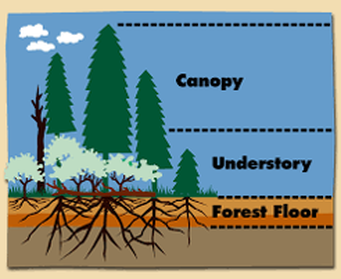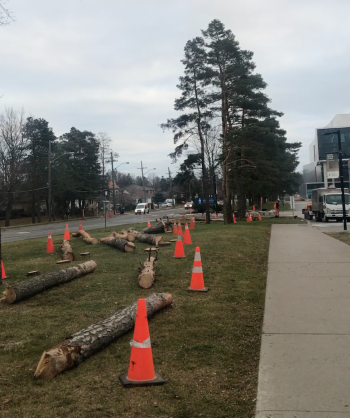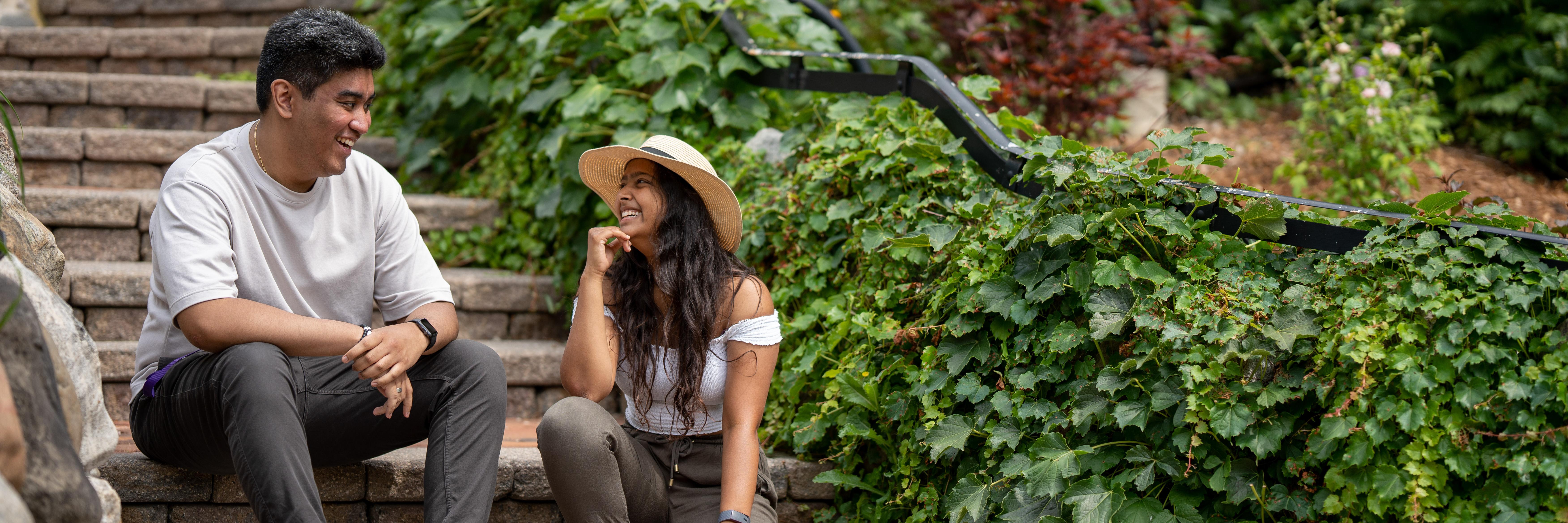University of Toronto Scarborough resides on a landscape that is highly diverse in ecology and function, supporting the needs of the entire UTSC community. This greenscape is maintained and cared for by the UTSC grounds team.
This monumental task requires a whole ecosystem perspective, which means that staff take into account the health and needs of the plants, insects, trees, rivers, soil, air and animals--including the human kind.
According to the model of holistic stewardship, humans can co-exist sustainably with all other members of the ecosystem, giving back to the environment just as much as they take away. The grounds team works to maintain greenspaces that facilitate human access and enjoyment without sacrificing the health and biodiversity of the ecosystem.
Read on to learn more about our lawns, gardens and forests.

Lawns and Gardens
A whole ecosystem approach requires striking a delicate balance. Lawns, for example, are not ideal for ecosystem health as they consume a large amount of resources without giving much back to the ecosystem by way of food or habitat. However, they are important accessible spaces for play and leisure for students, staff and community. To offset their impact on the ecosystem, the grounds team ensures these spaces are maintained using the most sustainable methods possible, including low-mow techniques, low-water usage, and natural methods of weed and pest control.

These lawns and sports fields are balanced with dedicated gardens featuring both native and ornamental plant species, combining biodiversity and human enjoyment.

UTSC staff choose plant species with a variety of factors. Some plants produce food and habitat for insects and animals. Some plants provide aesthetic interest in all seasons. Some plants are hardy, easy for the grounds team to maintain and requiring less watering. Plants also need to be resilient to the many stressors inherent in a university campus environment, such as trampling and road salt use during the winter.
To make the most of their resources, the grounds team gets creative—taking the time to split and propagate existing plants for use in different areas of campus. Fallen campus trees are used to make mulch and planter boxes. A number of indoor plants seen around campus were originally props used in a film shot on campus, destined for the garbage dump after the movie finished filming. UTSC staff were all too happy to step in and give the plants a permanent home.
Forests
The Valley Land Trail was opened in 2019 to connect the campus on the valley ridge with the Highland Creek Valley below. The award-winning trail was designed for minimal ecosystem impact while facilitating access for students, staff and community members of all abilities. The valley is a designated Environmentally Significant Area, containing valuable swamp and marsh habitats, six rare fauna species and a diverse forest, stewarded in partnership with Toronto Parks and the Toronto Regional Conservation Authority (TRCA).

Apart from the valley, the rest of UTSC’s tree canopy presents a challenge for forest stewardship.

There are three layers to a healthy forest: a canopy layer (consisting of tall, leafy trees), an understory layer (consisting of smaller trees and shrubs) and a ground layer (consisting of mosses, grasses, fungi, and decaying leaves and fallen trees). Each layer corresponds to the age of the forest. A new forest has only grasses and shrubs. A young forest has grasses, shrubs and fast-growing trees such as pine and birch. An old forest will have grasses, shrubs, and tall, slow-growing trees such as oak and hemlock.
This gradual change in the make-up of a forest community over time is called forest succession. This change is driven by a variety of factors. Some species thrive in the abundant sunlight of a new forest, whereas others prefer to grow in the shade of a young forest. Different species have different lifespans, after which they naturally begin to weaken and die.
Different species are also resilient to different stressors, such as wildfires, drought, floods, diseases or pests. These kinds of stressors are natural occurrences that come and go in cycles, and they play an important role in ecosystem health by killing weak trees and driving forest succession. Healthy forests are able to survive these regular events by having a high level of biodiversity--as one species dies, a more resilient species takes its place.
If a forest is dominated by only one or two different tree species, this is called a monoculture. Monoculture forests are at high risk for being wiped out completely by natural events, destabilizing the entire ecosystem. The mountain pine beetle, for example, has wreaked havoc on forests in British Columbia, where monocultures of lodgepole pines were planted by the timber industry for decades. Closer to home, the emerald ash borer has left holes in large parts of Toronto's urban canopy due to ash trees being planted in monocultures.

When UTSC was built in the 1960s, the campus was planted in monocultures, with certain areas planted in clumps of only one tree species. In the decades since, there has been a lack of forest succession planning, with scarcely any new trees or understory plants planted until very recently.

The result of this lack of planning is most clearly seen today on front campus, where a number of scots pines were planted along Military Trail as the campus was being built.
Scots pines have a natural lifespan of 80 years, meaning these trees are now weakening and dying all at the same time, leaving large gaps in the campus forest canopy where there are no other species to take their place.
The current grounds team is working to leave a better legacy when it comes to forest succession. In spring 2023, UTSC partnered with the TRCA to plant 100 new native trees and shrubs around the south campus residence in the largest planting effort in years.
Beyond biodiversity considerations, it is now necessary to consider climate change in forest succession planning. Tulip, black gum and shagbark hickory are all species that were provided to UTSC by the TRCA, despite being native to forests found further south in the eastern United States. As Toronto's climate warms, it is possible that many of our native species will be unable to adapt, making it necessary to plant warmer climate species to preserve our urban canopy.
Central to preserving the health of our new and existing campus trees is healthy soil. Traditional mowing practices naturally disrupt the growth of the ground and understory species that are vital to maintaining the health of the soil through nutrient cycling. Mowing is necessary in areas where humans of the campus community need to pass through, but it does impact the health of the soil. To offset this effect, the grounds team is building the health of the soil by identifying areas of the campus where frequent mowing is unnecessary.
As an example, the oak trees by the south campus residence centre are being restored by emulating an “oak savannah” ecosystem. By instituting low-mow practices, the understory layer has been allowed to grow back, restoring the health of the soil. This project has already seen significant improvement in the health of the oak trees, allowing them to rebound from the spongy moth infestation of 2021.

